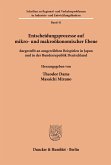This book contains the revised and updated versions of twelve papers which were presented at the 17th joint seminar of the faculties of economics of the Universities of Nagoya and Freiburg. The seminar took place in 1997 in Nagoya and marked the 25th anniversary of the cooperation between both faculties. The subjects of the book concentrate on long-term economic and business issues common to Japan and Germany on the turn of our century.Firstly, both countries experience continuing and interrelated problems in the labor market, budget deficits, demographic changes and the future of the social security system. Secondly, globalization, technical progress and shift of social values lead to structural changes of the economy and its institutions, particularly to deregulations and network economies. As a consequence, new ways of cooperation between firms, customers and suppliers will be established. Thirdly, the network economy changes also the inner structure and management of the companies in both countries including new organizational patterns such as the holding company or the virtual enterprise, the tight cooperation of small and medium-sized companies, human resource management and compensation.Although the broad issues in both countries - as in other mature economies - are essentially the same, the details under the surface are different and therefore ask for different solutions. The identification of these similarities and differences by theoretical and empirical methods constituted a key objective of the seminar, as well as of previous seminars.
Bitte wählen Sie Ihr Anliegen aus.
Rechnungen
Retourenschein anfordern
Bestellstatus
Storno








